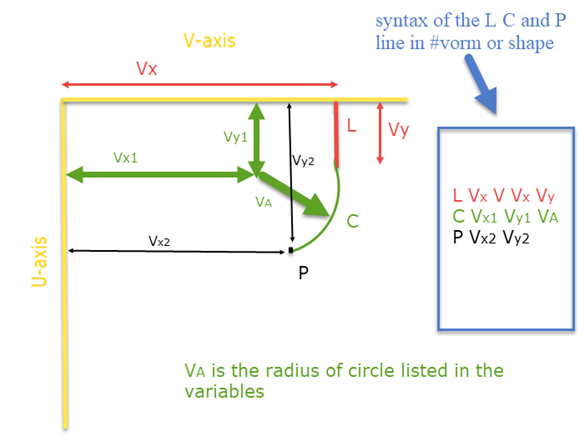Shape definition (brackets)
The #vorm section in bracket type files defines the shape of the bracket using the Axis variables defined in the previous sections of the type file.
Each line in the #vorm section is a shape line which consists of a line code followed by values defining point coordinates, a radius, or a distance. There are five types of shape lines: L, C, P, F/G, and E.
|
Line type and Line Code |
Purpose |
|---|---|
| Line segment line L | Defines a line drawn between two defined points. See L line. |
| Arc line C | Defines an arc. See C line. |
| Point line P | Defines a point. See P line. |
| Flange line F and Face plate line G | Defines a starting or end point of a flange or a face plate on the bracket contour. See Flange and face plate lines (F, G). |
| End line E | Indicates the end of the shape definition. See E line. |
Important: The last point of the contour definition must be the same as the first point. This ensures that the contour is closed.
A part of the shape can be defined relative to construction line coordinate systems by using LC1, LC2 or LC3 for lines, PC1, PC2 or PC3 for points and CC1, CC2 or CC3 for arcs. See Construction lines for more information.
Syntax in the #vorm section
The lines which define the bracket's shape (L, C, P, F/G) have the following syntax.
Note: This syntax is only applicable to the #vorm section of the bracket type file.
L <X coordinate> <Y coordinate> <X coordinate> <Y coordinate> {<Bevel\weld connection code> {<var offset> {<var offset>}}}
LC<line number> <X coordinate> <Y coordinate> <X coordinate> <Y coordinate>
P <X coordinate> <Y coordinate>
PC <line number> <X coordinate> <Y coordinate>
C <X coordinate> <Y coordinate> <var> {<Bevel\weld connection code> {<var offset> {<var offset>}}}
C <X coordinate> <Y coordinate> ? {<Bevel\weld connection code> {<var offset> {<var offset>}}}
C ? ? <var> {<Bevel\weld connection code> {<var offset> {<var offset>}}}
C ! ! <var> {<Bevel\weld connection code> {<var offset> {<var offset>}}}
C # # <var> {<Bevel\weld connection code> {<var offset> {<var offset>}}}
C L <! | ? | #> <var> {<Bevel\weld connection code> {<var offset> {<var offset>}}}
C <! | ? | #> L <var> {<Bevel\weld connection code> {<var offset> {<var offset>}}}
C S <# | ? | !> <var> {<Bevel\weld connection code> {<var offset> {<var offset>}}}
CC <line number> <X coordinate> <Y coordinate> <var> | <X coordinate> <Y coordinate> ? | ? ? <var> | ! ! <var> | # # <var>
F S <var>
F E <var>
G S <var>
G E <var>
<X coordinate> := <A expression> [;<A expression>[;<A expression>[;<A expression>]]]
<Y coordinate> := <expression>[;<expression>[;<expression> [;<expression>]]]
<A expression> := U | V | X | Y | A <arithexp> | C <arithexp> | P <arithexp>
<expression> := U | V | X | Y | <arithexp>
<arithexp> := <var> [<operator><arithexp>]
<operator> := + | | * | / | ^ | c | C | s | S | t | T
<var> := U | V | X | Y | Ui | Vi | Xi | Yi | Rj | BT | DPk | HPk | LPk | BPk | BLn |
BA | BB | BC | HRn | HX1n | HX2n | HX3n | HX4n | HX5n |
HY1n | HY2n | HY3n | HY4n | HY5n
i = 1..9, A..Z j = 1..8 k = 1..4 n = 3,4
<var offset> := [\{ A | F }] <var>
<Bevel\weld connection code> := BRR1 | BRR2 | BRR3 | BRR4
Lines, arcs, points, and flange or face plate starting and ending points are defined in the L, C, P, and F/G lines, respectively, as follows:
-
L lines – The starting and end points are defined by X (-x to the left +x to the right) and Y (-y down +y up direction) coordinates. See L line.
-
C lines – An arc is defined by a midpoint point in the X and Y directions, and a radius (negative for clockwise, positive for counterclockwise). See C line.
-
P lines – The point is defined in the X and Y directions. See P line.
-
F and G lines – S indicates a starting point, and E indicates an end point of a flange or face plate. See Flange and face plate lines (F, G).
Note: The first coordinate of a point (also a point on a line) or circle must be defined using a U, V, X or Y variable. The first coordinate defines the coordinate system (axis system) that the point is on.
For information on the U, V, X and Y variables, see Coordinate systems and Axis variables.
For bracket-related bevel and weld information, see Bevels on brackets.
Example
Below is an example of how the L C and P lines make up the contour of the bracket.
